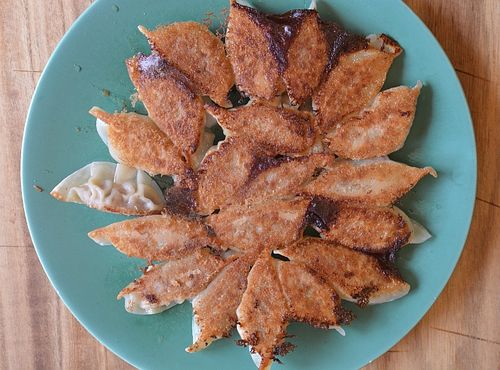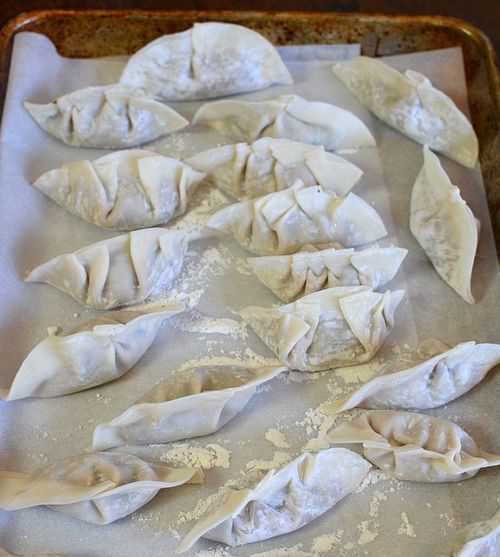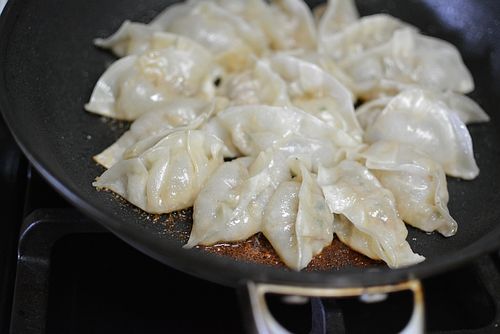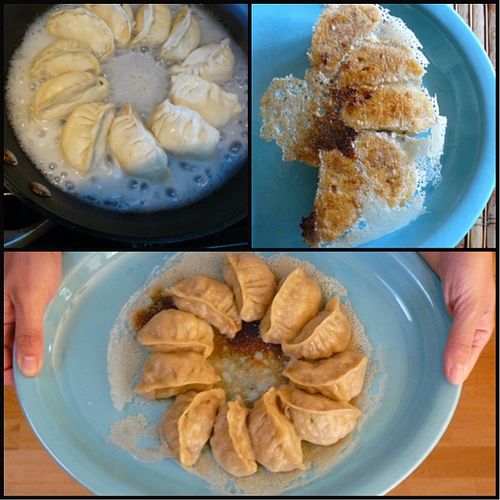Happy food accidents are the best kind to have. Last week I was working on dumpling recipes for a magazine article and was using store bought pot sticker/gyoza wrappers. They are well dusted with starch, as evidenced by the streaks of white on each one. There is usually one side that has more starch than the other and I was shaping many of the dumplings with the starch side of the wrapper facing out. To test how long they’d last in the fridge, I put the shaped dumplings on a parchment-paper lined baking sheet that I’d dusted with flour.
The skins were rather thin so I was worried that they’d get soggy so I was more generous with the flour than usual. (Who wants their dumplings ruined by moisture?) After the dumplings were shaped, they got refrigerated for 2 hours before I pan-fried them.
I employed my usual method of “fry-steam-fry” to cook the dumplings in the skillet, adding some water for the steaming part of the process. When the dumpling were done, they stuck a bit to the skillet. I lowered the heat, hoping they need a little extra time before they’d easily dislodge themselves. When I make pot stickers using fresh skins that I roll out, this isn’t a problem and the cooked dumplings slide around in the skillet on their crispy bottoms.
I waited and finally took a thin spatula to nudge the dumplings. Lo and behold, the entire thing slid. Ha, there was enough starch and flour to “knit” the dumplings together. I decided to try a fun cheap dumpling trick. After shaking the skillet a few times to wind up, I turned the entire thing out onto a platter. Success. A couple of pot stickers fell off and were put back into place. Charming and tasty.
Obviously, you can do this on purpose by sprinkling extra flour on your baking sheet when dusting it. On Facebook, Karena Man shared this: "I used to unwittingly get this effect by cooking my just-folded potstickers with the water I used to seal the edges. I guess there was enough starch in the water to produce this effect, but I never put two and two together. I was just trying to save water!"
Or, take things further by adding a slurry of water and rice flour to the skillet instead of water.
I wrote about the lacy crispy skirt in 2009 ago when I first encountered it in Melbourne. With the help of friends Robyn Liang in New Zealand, Asian food experts Chris Tan and Fuchsia Dunlop, and Yael Coty, a former Saveur test kitchen intern, we figured it out. Pot stickers are typically served crisp bottoms up but with the skirt, the bottoms stay crisp for a long time, even if you serve them bottoms down on the plate. I’m sure you can use the leftover slurry as a light thickening agent. No waste, right?
RECIPE
Pot Stickers with a Crisp Skirt
Yields: 32 dumplings, serving 4 as a main course, 6 to 8 as a snack
Ingredients
- 3 tablespoon regular rice flour, any Thai brand, such as Erawan (3-Headed Elephant)
- ¼ cup tap water
- 1 ⅔ cups just-boiled water (bring to a boil, pull off the heat and allow the bubbling action to rest)
- Canola oil
- 32 uncooked pot stickers (see recipes in Asian Dumplings, Chapter 1 “Filled Pastas” or try ones from another recipe, even with store-bought skins)
- Dipping sauce of choice (soy sauce, Chinkiang or unseasoned rice vinegar, chile oil or a combo)
Method
1. Put the rice flour in a bowl and whisk in the tap water to make a smooth batter. Then whisk in the just-boiled water to yield a milky, opaque slurry. Set aside.
2. To panfry the dumplings, use a medium or large nonstick skillet; if both sizes are handy, cook two batches at the same time. Heat the skillet over medium-high heat and add 1 ½ tablespoons of oil for a medium skillet and 2 tablespoons for a large one. Add the dumplings one at a time, placing them, sealed edges up, in several straight rows. The dumplings may touch. Fry the dumplings for 1 to 2 minutes, until they’re golden or light brown at the bottom.
3. Holding the lid close to the skillet to lessen the dramatic effect of water hitting hot oil, ladle in enough of the slurry to a depth of about ¼ inch; expect to use about ⅓ cup of the slurry. Things will immediately sputter and boil vigorously like a pot of rice. Cover with a lid or aluminum foil, decrease the heat to medium, and let the water bubble away until it is mostly gone and a starchy white residue remains, 8 to 10 minutes. After 6 to 8 minutes, move the lid or foil so that it is slightly ajar to allow steam to shoot out from underneath.
4. When the bubbling noise turns into gentle frying (a sign that most of the water is gone), remove the lid. Allow the dumplings to fry for another 3 to 5 minutes, or until all starch has crisp up and there’s some browning in the resulting skirt. Try picking one up and the skirt should lift off the pan. Turn off the heat, wait for the cooking action to cease, and then give the skillet a gentle jerk to ensure that the skirt releases. Slide the dumplings and skirt to a serving plate. Or, cover the pan with a plate and carefully (but quickly) invert the pot stickers and their skirt onto the plate. Serve immediately with the dipping sauce of choice.




















